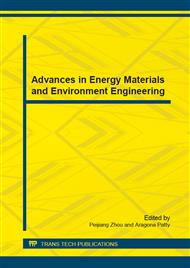[1]
B S Zheng , J Zhang , Z H Ding, et al. Issues of health and disease relating to coal use in southwestern China. International Journal of Coal Geology, 1999, 40(2-3): 119-132.
DOI: 10.1016/s0166-5162(98)00064-0
Google Scholar
[2]
S F Dai, D Y Ren, S M Ma. The cause of endemic fluorosis in western Guizhou Province, Southwest China. Fuel, 2004, 83(14-15): 2095–(2098).
DOI: 10.1016/j.fuel.2004.03.016
Google Scholar
[3]
S F Dai, W W Li, Y G Tang, et al. The sources, pathway and preventive measures for fluorosis in Zhijin County, Guizhou, China. Applied Geochemistry, 2007, 22 (5): 1017–1024.
DOI: 10.1016/j.apgeochem.2007.02.011
Google Scholar
[4]
O Lyth, . Endemic fluorosis in Kweichow, China. The Lancet, 1946, 1: 233-235.
DOI: 10.1016/s0140-6736(46)91349-9
Google Scholar
[5]
Z D Wei, L Y Zhou, RC Bao, et al. Endemic Fluorosis in Guizhou China . Fluoride, 1980, 14( 2) : 91-93.
Google Scholar
[6]
R B Li, J A Tan, Wang W Y, Wang L Z. Discussion on fluorine source for endemic fluorosis caused by food in Guizhou. National Medical Journal of China. 1982, 62( 7): 425-428.
Google Scholar
[7]
B S Zheng, R G Huang. Study of fluorine content of Chinese coal. Chinese Journal of Control of Endemic Diseases. 1988, 3( 2) , 70-72.
Google Scholar
[8]
D S Wu, B S Zheng, A M Wang. A new estimation of fluoride source in coal-burning endemic fluorosis areas of Guizhou province. Chinese Journal of Endemiology, 2004, 23(2): 135-137.
Google Scholar
[9]
S F Dai, D Y Ren, S M Ma. Endemic Fluorosis in western Guizhou:new discovery. Geological review, 2005, 51(1): 42-45.
Google Scholar
[10]
K L Luo, H J Li, F J Feng, et al. Content and distribution of fluorine in rock, clay and water in fluorosis area Zhao tong, Yunnan province. Journal of China Coal Society, 2007: 32(4): 363-368.
Google Scholar
[11]
W Y Wang, Y H Li , K L Luo, et al. The geochemical characteristics of selenium and fluorine in soils of Daba Mountains[J] . Geographical Research, 2003, 22(2):177-184.
Google Scholar
[12]
K L Luo , H J Li, T B Chen, et al. Content of arsenic , Selenium, mercury in the coal, food, clay and drinking water in the Zhao tong fluorosis area, eastern Yuan nan Province[J]. Journal of China Coal Society, 2008, 33(3):289-294.
Google Scholar
[13]
H D Liang, Y C Liang, J A J Gardella, et al. Potential release of hydrogen fluoride from domestic coal in endemic fluorosis area in Guizhou, China. Chinese Science Bulletin, 2011: 56(22 ): 2301-2303.
DOI: 10.1007/s11434-011-4560-6
Google Scholar
[14]
Y P Fu, X C Wang, X Chen. Distribution of soil pH and its relationships with soil nutrients in Bijie tobacco-growing Area. Soils, 2013, 45(1): 46–51.
Google Scholar


